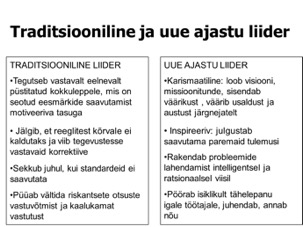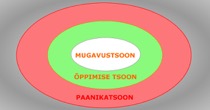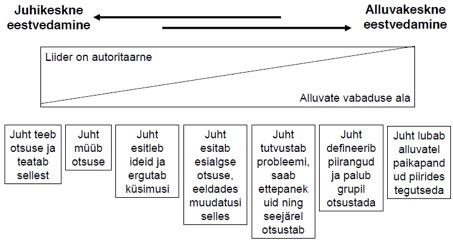To put it simply, a person is always in one of three zones: comfort, discomfort or panic. Development only happens when you are in a mildly uncomfortable ‘learning zone’. However, the size and boundaries of each employee’s (including the manager’s) zones is what makes the job of a manager exciting and passionate.
Developing people seems to be the job of the training department for classic managers. It is based on the 20. the so-called “Teilorism” of the early twentieth century, where process efficiency was paramount and the human being was only a means to achieve efficiency and productivity in the production process. The main role of the manager was to set the standard and make the employees act accordingly. Unfortunately, we still see too much of this kind of leadership in today’s organisations.
Today’s and tomorrow’s leader, however, needs to focus on mentoring and counselling, and through person-centred work, bring out the best in people. More and more of the work is ‘brain work’, i.e. the use of intellectual capital. However, this work is no longer managed by the process manager alone and the brain does not exist only for the manager. In order for an organisation (or a collection of individuals working towards a common goal) to be ready to cope with a rapidly changing environment and the new demands of new generations, all employees need to be able to survive and initiate new situations and be creative solution creators. It’s up to managers to bring out this willingness and skills in their employees.

Of the core management functions (planning, organising, leading and controlling), leadership should take a larger share of the front and middle managers’ desks to achieve the best results:
– first line managers (non-managerial staff) reportedly ½ of the time.
– for a mid-level manager (1-2 levels of management) about 1/3 of the time.
What is leadership?
Leadership is influencing people to achieve the best results for the organisation. It’s about creating a shared culture and values, about making sense of objectives for and with employees. Whether it’s through group meetings or 1:1 conversations, where peer-to-peer influence and inspiration is most effective.
More than 10 years ago, research proved that 81% of leadership failures are due to inadequate communication skills or practices. While the power of leaders is based on hierarchical position, the power of leaders derives from their authority, where communication practices are no longer limited to simply sending information “from the top down”. Often, the leader may not have the clout of authority, and the clout is greater for a team member who does not have the title of leader. However, both (leader and leader) use their influence to get things done, and every leader should be more of a leader than a manager.
But how can we develop it anyway?
To put it simply, a person is always in one of three zones: comfort, discomfort or panic.

Development only happens when you are in a mildly uncomfortable ‘learning zone’. In order to understand the boundaries of each worker’s zone, it is not possible to know unless you know the person personally. The process does not tell the manager. Some knowledge of psychology helps, but there is still no manual for people and you have to communicate with the employee all the time. In fact, according to psychologists and brain chemistry researchers, reciprocal influence can only take place if there is at least 20 minutes of mutual and equal contact on a single subject.
It is the manager’s job to consistently guide the employee into the learning zone through different new experiences. This constantly expands the employee’s comfort zone, where things are done in a bolder, more professional, more experienced and so on. These people have less anxiety and are more prepared to adapt to the changing environment around them (VUCA!).
How do you do it as a leader?
An adult learner learns best by practising, and least by learning from someone else. He or she wants to experience it for themselves and relate what they learn to their work, so that the impact of development activities is sustainable. The 70-20-10 principle is widespread in the development of people, which also implies basically little faith in the effectiveness of classical training.
70% of learning is through individual experience (some examples I have used as a manager: reflecting on what the employee has done in 1:1 conversations, presenting something to others in a team, solving recurring problems across teams and analysing the solutions later, conducting or participating in research, mentoring new people or colleagues, leading or participating in projects, conducting training for colleagues, etc.).
20% learning through the experience of others (observation, mentoring, acting as a coachee, role-playing, case discussions).
10% through structured courses or programmes (e-learning, training, conference). However, due to the chemistry of the brain (the interconnection of neurons is an article in itself), after the training, more than 90% of the content is forgotten within 48 hours.
In my practice, one of the most effective methods of guiding team members into the learning zone is to give them leadership or active involvement in various projects. There will be mistakes along the way, but as a manager you have to let the employee make those mistakes, so that the person learns the most from the subsequent analysis. The analysis itself is also an uncomfortable activity that forces you to step out of your comfort zone.
However, projects must always be directly related to the work, because all development work is ultimately about achieving the organisation’s objectives. Projects can also direct people to colleagues or in-house partners they would not otherwise have come into contact with.
Developing people in a business cannot be an end in itself, the goal is still to achieve results through development. In order to reach a situation where a person is ready to adapt quickly to change, it is necessary for the leader to move down the scale towards more freedom for the subordinate.

People need to feel free, without freedom there is no responsibility, which the constantly changing environment requires from each of us.
Where are you as a leader on this chart? Where do you want to be? How soon? What are you doing?
Briefly, the main idea of Article 3:
1. The biggest part of the desk of a first and middle manager is leadership and development.
2. Development is carried out by the manager through “additional tasks” that develop the employee.
3. The best development takes place when a person is regularly guided into a zone of discomfort or learning. It requires getting to know the employee and agreeing together on his or her potential or development needs.

